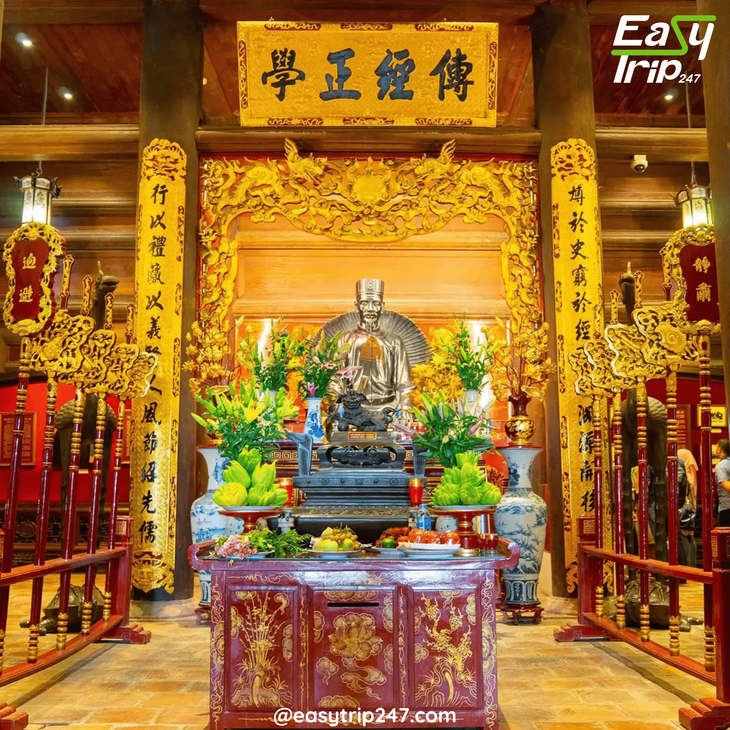Why the Temple of Literature Matters: Its Cultural Significance in Vietnam
On
23/06/2025Reading time:
1 min
Summary:
In the heart of bustling Hanoi lies a haven of intellectual grace, serene courtyards, and ancient wisdom — the Temple of Literature Hanoi. More than just a tourist destination or a historical monument, this temple is a national treasure deeply embedded in the spiritual and cultural fabric of Vietnam.

The Temple of Literature Hanoi was founded in 1070 under Emperor Lý Thánh Tông and dedicated to Confucius, the renowned Chinese philosopher. Just six years later, in 1076, it became home to Vietnam’s first national university — the Imperial Academy — a center of higher learning for the nation’s brightest minds. This makes the Temple of Literature Hanoi not only a place of worship but also the birthplace of Vietnamese education. It is here that generations of scholars, mandarins, and moral leaders were trained in the Confucian classics, preparing them for civil service examinations and roles in government.
As one of the few remaining structures that celebrate Confucian education and philosophical values in Southeast Asia, the Temple of Literature Hanoi holds immense cultural significance. The layout of the temple itself is based on classical Confucian principles. It consists of five courtyards, each symbolizing stages of intellectual and spiritual development. Visitors enter through the grand Van Mieu Gate and walk a path flanked by ancient trees, koi-filled ponds, and quiet pavilions that invite contemplation and reverence.
One of the most iconic features of the Temple of Literature Hanoi is the Stelae of Doctors — 82 stone steles standing on the backs of stone turtles, a symbol of longevity and wisdom. These stelae, inscribed with the names of those who passed the royal exams from 1442 to 1779, are invaluable historical records. They honor Vietnam’s intellectual elite and highlight the importance placed on knowledge and academic achievement — a legacy that still resonates strongly in contemporary Vietnamese society.
The Temple of Literature Hanoi isn’t just a relic of the past; it’s a living cultural space. Every year, thousands of students visit before their university entrance exams to light incense and seek good fortune in their studies. During the Lunar New Year, calligraphy masters gather here to write auspicious characters for visitors, continuing a beautiful tradition that merges language, art, and hope for a prosperous year ahead. These customs keep the Temple of Literature Hanoi vibrant and relevant, breathing life into ancient teachings.
Moreover, the temple serves as a reminder of Vietnam’s unique approach to cultural synthesis. While Confucianism originated in China, the Temple of Literature Hanoi represents how these teachings were adapted and localized to suit Vietnamese values and governance. The temple’s longevity, surviving wars, invasions, and colonial periods, underscores its role as a cultural anchor. In times of hardship and transformation, it has remained a steadfast symbol of dignity, learning, and identity.
The architectural elegance of the Temple of Literature Hanoi is also a testament to the craftsmanship of Vietnam’s past. Traditional red lacquered wood, tiled roofs, intricately carved motifs, and bonsai-lined walkways combine to create an atmosphere of poetic calm. Whether it's the Khue Van Pavilion — often used as a symbol of Hanoi itself — or the serene Well of Heavenly Clarity, every detail in the temple's design is infused with meaning. For those interested in both culture and aesthetics, the Temple of Literature Hanoi offers a unique experience that’s as intellectually rich as it is visually stunning.
Tourists and locals alike find in the Temple of Literature Hanoi a rare place of harmony in a fast-changing world. It encourages visitors to pause, reflect, and reconnect with values that transcend time: respect for teachers, the pursuit of wisdom, and the belief that moral character is as important as academic success. These timeless ideals, embodied in the temple’s history, make it more than just a place to visit — they make it a place to feel.
The location of the Temple of Literature Hanoi, close to the city center, makes it easily accessible, yet it feels worlds away from the noise and energy of Hanoi’s traffic and markets. It offers a peaceful retreat where travelers can learn not only about Vietnamese history but also about the inner journey of knowledge, self-discipline, and human potential. This blend of outer beauty and inner depth is what continues to draw people from around the globe to its gates.
Importantly, the Temple of Literature Hanoi plays a vital role in educating younger generations about their heritage. Schoolchildren on field trips, university students documenting Vietnam’s intellectual past, and even international scholars studying Confucianism all find invaluable insight within its walls. As modern Vietnam grows rapidly in technology and global trade, places like the Temple of Literature Hanoi remind the nation of its cultural roots, grounding progress in tradition.
Cultural preservation efforts in recent decades have helped restore and maintain the Temple of Literature Hanoi, ensuring that its significance is not lost to time. Restoration projects funded by both the Vietnamese government and international partners have safeguarded its structures, stelae, and gardens. Events such as the Spring Calligraphy Festival and the annual cultural week keep it alive not just as a monument, but as a community space.
In the broader context of Vietnam’s historical narrative, the Temple of Literature Hanoi is both a mirror and a beacon. It reflects centuries of Vietnamese thought, resilience, and reverence for education. At the same time, it continues to light the way forward, inspiring individuals to strive for intellectual and ethical excellence. For this reason, it is more than appropriate to say that the Temple of Literature Hanoi matters deeply — not just as an architectural gem, but as a cultural cornerstone.
Whether you are a traveler seeking to understand Vietnam beyond its food and scenery, a student of history exploring the legacies of Eastern thought, or simply a curious visitor yearning for quiet beauty, the Temple of Literature Hanoi offers something profound. It whispers stories of the past and speaks to the soul of the present. Its timeless relevance ensures that it will remain a treasured part of Vietnam’s identity for generations to come.
Design Your Tour Today And Get A Quote. Contact Us Here: +84.975.504.825
Source: Easytrip247 Team compiled.
